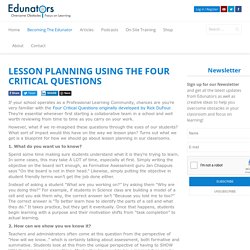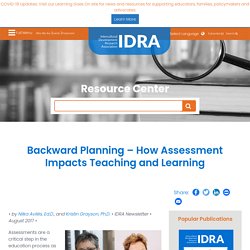

7. Differentiation Techniques for Special Needs Students - Differentiation & LR Information for SAS Teachers. Students with special needs may need to have their work differentiated in a specific way to meet their IEP goals.

Below are some suggestions that can be integrated into lesson plans. Assessments - While students with special needs may become proficient readers and writers, they should not be limited to this to show what they know. Posters, models, performances, and drawings can show what they have learned in a way that reflects their personal strengths. When it comes to tests, there are other ways to show mastery than a multiple choice test. Three Easy Ways To Differentiate Instruction - Edunators. Differentiated Instruction is a popular buzzword in many education circles, and while some teachers pass it off as “chaotic” or “too much work” the true Edunators amongst us have learned how to embrace this as one of the essential Weapons of Mass Education.

While many teachers use Differentiated Instruction to provide more targeted instruction where kids need it most, usually after some bit of formative assessment, it can also be used as means of delivering initial instruction. There are essentially three ways in which teachers can easily differentiate instruction, give them a once over and see if there’s anyway you can tailor your instruction to meet the needs of the individual a bit more in your classroom. 1) Differentiate how students learn necessary course material. Whether it’s by taking notes during a class lecture, playing a game, reading a textbook, or watching a video at home, there are a variety of ways students can come to “know” course material. Lesson Planning Using The Four Critical Questions - Edunators.
If your school operates as a Professional Learning Community, chances are you’re very familiar with the Four Critical Questions originally developed by Rick DuFour.

They’re essential whenever first starting a collaborative team in a school and well worth reviewing from time to time as you carry on your work. However, what if we re-imagined these questions through the eyes of our students? What sort of impact would this have on the way we lesson plan? Turns out what we get is a blueprint for how we should go about lesson planning in our classrooms. 1. Spend some time making sure students understand what it is they’re trying to learn. Instead of asking a student “What are you working on?” 2. Teachers and administrators often come at this question from the perspective of “How will we know…” which is certainly talking about assessment, both formative and summative. Top Tech Tools for Formative Assessment. Research Based Assessment Practice - Google Slides.
Backward Planning – How Assessment Impacts Teaching and Learning - IDRA. • by Nilka Avilés, Ed.D., and Kristin Grayson, Ph.D. • IDRA Newsletter • August 2017 • Assessments are a critical step in the education process as they determine whether the learning objectives of a lesson have been met.

By showing students’ understanding of concepts taught, assessments enable teachers to see if their teaching has been effective. Assessment affects students’ grades, placement, curriculum progress and enrichment, instructional needs, and even school resources and funding. Assessments must address teaching for understanding through authentic activities that promote higher order thinking and construction of knowledge.
Using a backward planning approach to enhance teaching and learning is a renewed approach that challenges the traditional methods of curriculum planning. In traditional lesson planning, teachers begin with looking at what needs to be taught. Also, the activities may not contain evidence of learning and are not selected to match the assessment. Resources. RubiStar Home. What the Heck Is Inquiry-Based Learning? Inquiry-based learning is more than asking a student what he or she wants to know.

It’s about triggering curiosity. And activating a student’s curiosity is, I would argue, a far more important and complex goal than mere information delivery. Despite its complexity, inquiry-based learning can be easier on teachers, partly because it transfers some responsibilities from teachers to students, but mostly because releasing authority engages students. Teachers who use inquiry-based learning combat the “dunno”—a chronic problem in student engagement. When you ask a student something like, “What do you want to know about _____?” What inquiry-based teachers do isn’t easy at all; it’s just hidden, and some people confuse the two. Learning Something New Triggering inquiry is about learning something new, and triggering curiosity is no small feat. Let’s say you’re clicking through your Twitter or Facebook feed and you stumble on a link in your content area.
You have to bring that “whaaa?!” 1.